The next time you're sweeping cobwebs out of the corners, take a moment to appreciate the elaborate designs of these sticky bug traps
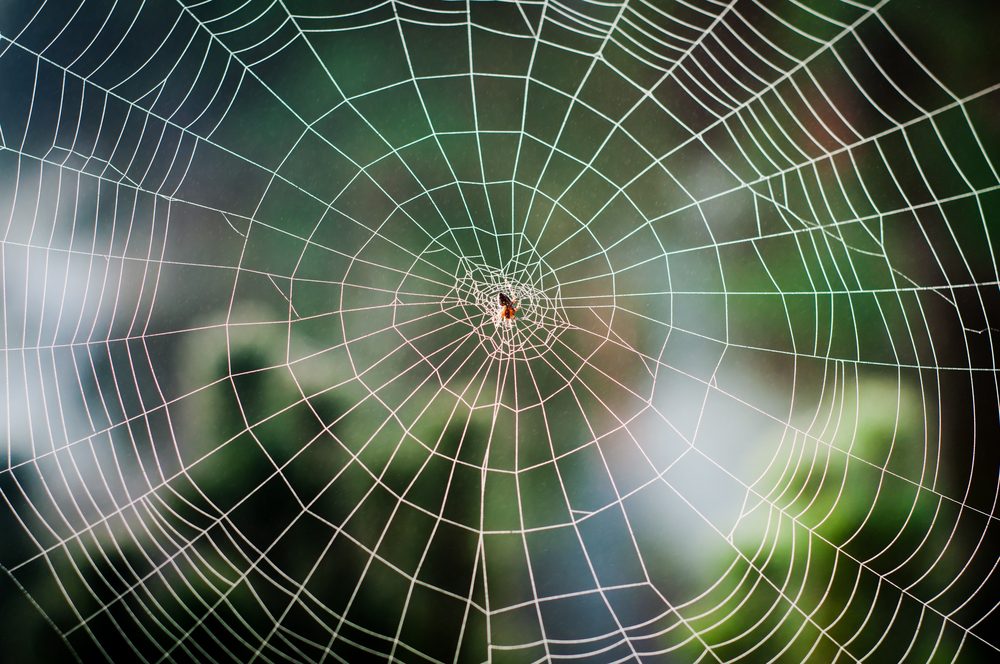
14 of the Most Beautiful Spider Webs Ever Found in Nature

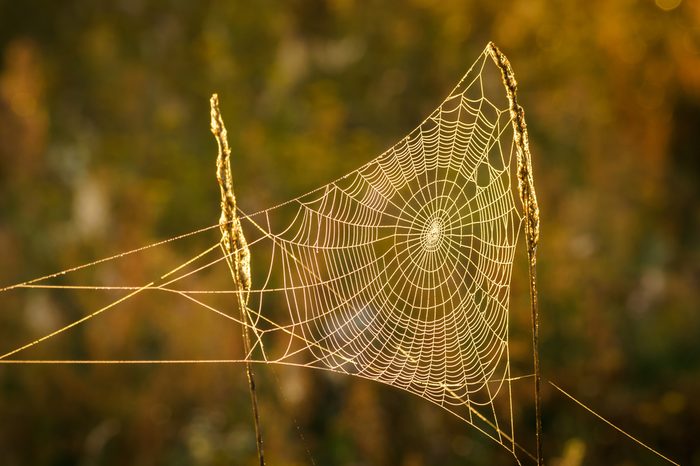
Orb webs
These circular creations are made by a class of spiders called orb weavers that includes lots of common garden spiders. They adjust their design based on which insects they’re most likely to capture: If they mostly catch flies, they use a tighter weave, and if they’re focused on crickets, the web has to be stronger and stickier so the thrashing bugs can’t break out before the spider can kill it with a bite.

Spider silk production
This golden orb-weaver spider has seven kinds of silk glands, and each one creates its own liquid protein (called spidroid). The proteins are solidified and combined in numerous ways to create strands with different uses, and they’re released as silk from six spinnerets. Some types of silk are used for web building, but others are made for egg cases or wrapping up prey. The golden orb-weaver is a pretty spider, but maybe not one you want inside your house!
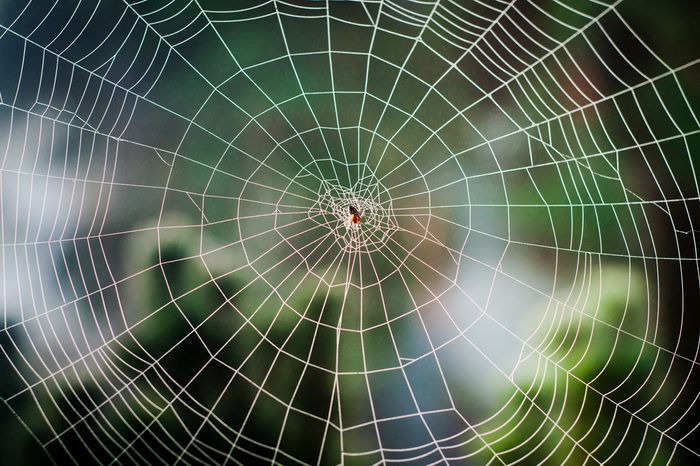
Arachnid architecture
On most orb webs, the threads that serve as spokes are stiffer and aren’t sticky. Once the structural supports are in place, the spider starts on the outside and spirals inward, attaching each segment of silk and coating the strands with a sticky substance. Once an unlucky bug gets stuck, killed and wrapped, this design generally maintains its strength, so the spider can make minor repairs rather than having to rebuild from scratch. This is important because web-building uses a huge amount of energy for the spider. (Sometimes they eat the webs they’re finished with, in fact.)
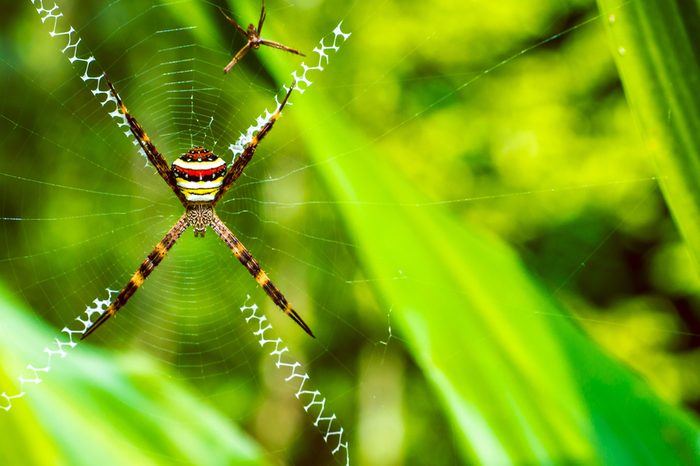
Web decoration
This St. Andrew’s cross spider has gone the extra mile to weave a special pattern, called a stabilimenta, into its web. Researchers aren’t sure why some orbweaving spiders do this—it could be to camouflage themselves or to look bigger to predators, or to make their webs more visible to creatures (like humans or other animals) that might otherwise accidentally crash through them. Scientists also theorize that the decorations reflect ultraviolet light in a way that attracts prey, or they might just help spiders maintain optimal body temperatures.
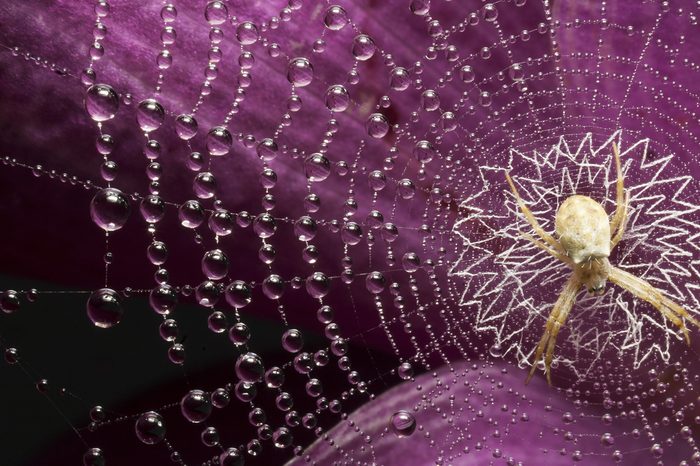
Silk art
Spider researchers (arachnologists) originally thought that stabilimenta added stability to webs, which is how the decorations got their name. But that theory has lost favor in recent years. Spiders might just have extra silk to use up, or maybe it’s just a female spider’s way of attracting a mate. Most male spiders never build webs, but—bizarre bug fact—they can spin silk, and some use it to wrap up dead bugs as gifts that they offer to females in order to keep from being eaten before they can mate.

One spider’s art is another’s junk
The trashline orbweaver doesn’t have a typical aesthetic sense—it wraps up poop, leftover pieces of prey and other debris in a straight line. The spider is camouflaged by this collection, and she typically keeps her egg sacs hidden among the trash too. Interestingly, these spiders have recently been found to have biological clocks that run naturally on an 18.5-hour cycle, rather than the 24-hour cycle found in every other animal studied, including humans, fruit flies and hamsters.
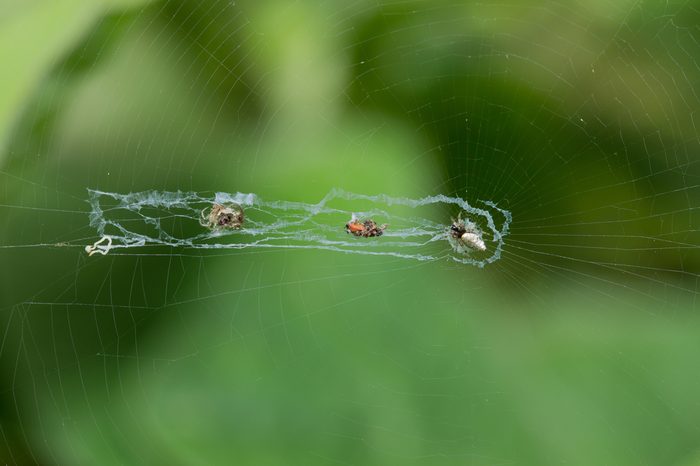
Tricky design
A spider found in 2012 in the Peruvian Amazon uses its trash in a more elaborate way, creating what looks like a decoy spider that hangs in its web. The fake spider is about an inch long, and its builder—a tiny spider that’s only about a quarter of an inch long—can shake the web to make the decoy appear to move. Scientists found another decoy builder in the Philippines the same year, suggesting that the behavior evolved separately in two places that are 11,000 miles apart.
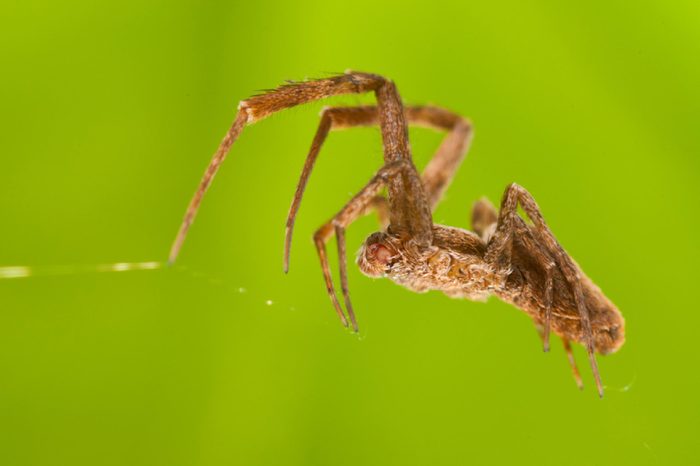
Electric lines
This feather-legged lace weaver has a slightly weird animal quirk and unusual method of catching prey: It spins super-tiny strands of silk from an organ called a cribellum that most spiders don’t have. Then it uses special hairs on its back legs to comb the nanoscale filaments of silk, which creates an electrostatic charge that leads the threads to have puffs on them that are very sticky without having any of the gluey substance that typically coats webs of other spiders.

Funnel weavers
Not all spiders build classic orb webs. There are hunters like the wolf spider that don’t build any webs at all, and others that create very functional—if less picturesque—webs, like the funnel-weaving spiders. They generally build webs with a flat surface for capturing prey and a tube that leads down to their own comfy burrow. The spider rushes out when it senses that an insect has gotten tangled in its silk and drags it down to its lair to eat.
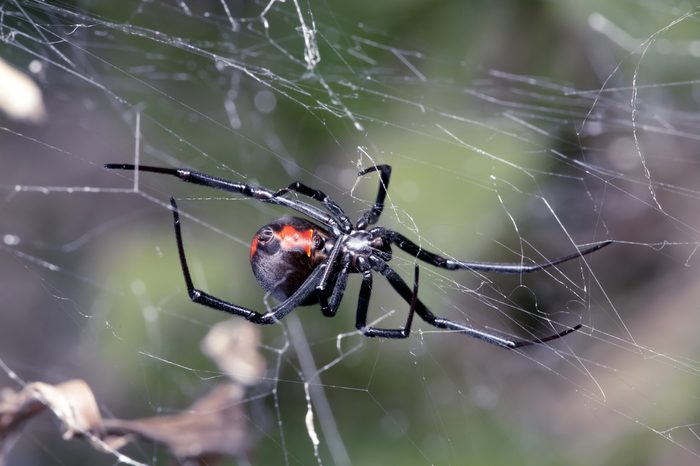
Black widow web
These famously venomous spiders build another variety of web, called a sheet web. It consists of a horizontal sheet of silk supported by threads going up to some support. Underneath, the black widow creates taut threads that hang down to the ground, where they’re attached by sticky glue. If an insect bumps into one of these, it detaches from the ground, sticks to the intruder and leaves it dangling. The spider feels the vibrations through the sheet and heads down for dinner.
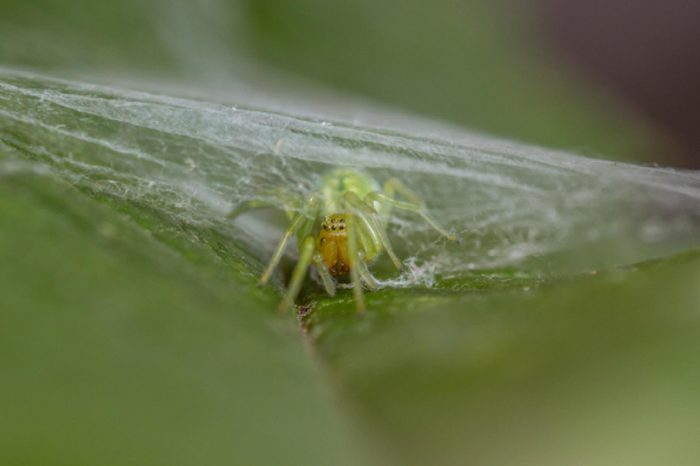
A tiny trap
This Nigma walckenaeri spider builds its mesh web on the surface of a leaf; it just needs a curved surface, so it can create a tiny hideout for itself in your garden. Other spider species create webs called the bowl-and-doily: A bowl-shaped web is suspended from plant stems and anchored on the bottom to a horizontal sheet (the doily). In a perfect example of nature’s booby trap, insects flying past bump into a thread and fall into the bowl, where they’re eaten by the spider.
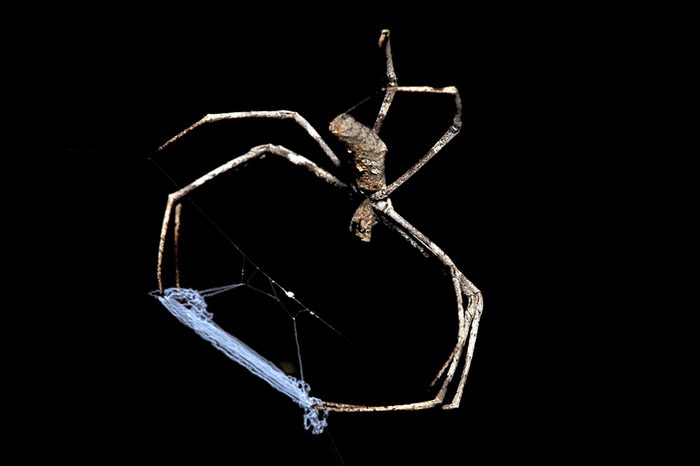
Tossing a net
The ogre-faced spider might be homely, but it has a very special skill set: Rather than building a large web to trap passing prey, it builds a tiny foraging web that it holds in its first two pairs of legs. Then it waits patiently until an insect happens to wander past, and it captures the bug with its net, like a 1960s-era cartoon Spider-Man catching the Green Goblin.
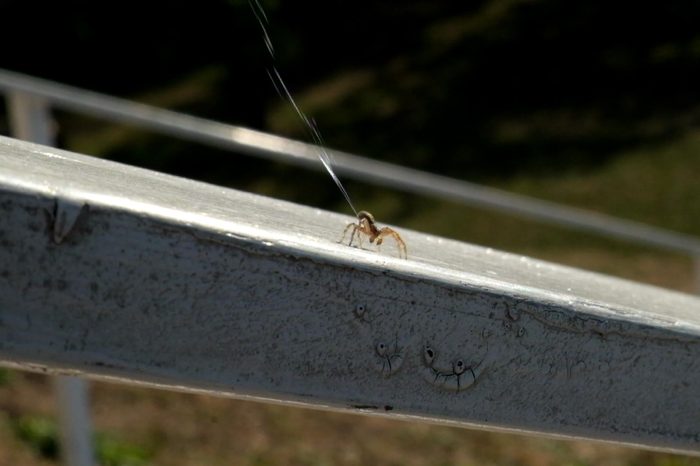
Ballooning
A spider’s silk isn’t just for trapping food. Many species are known to spin sails, catch the wind and fly off to a new locale. A study found that spiders raise one or two of their front legs to feel the wind speed (and possibly direction) for about six seconds. If it’s too cold and windy, they stay put, but when there’s a warm, gentle breeze, they release silk threads that form a triangular sheet and take off into the sky.
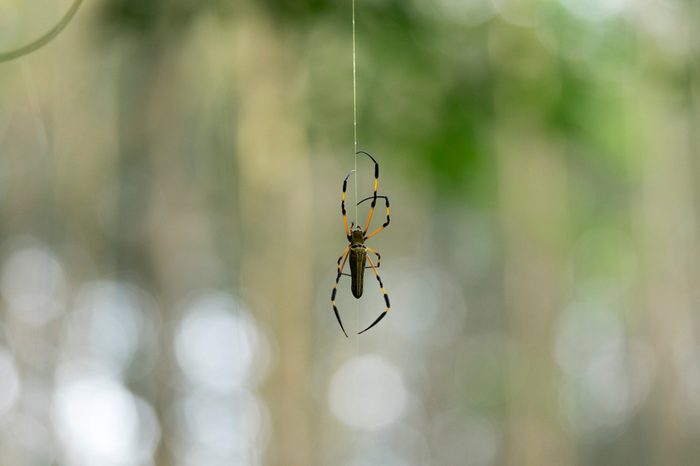
Strength and stretchiness
Dragline silk, which is what spiders use to hang from ceilings or webs, is several times stronger than steel on a weight-for-weight basis. It’s also stretchable, which is why webs can absorb the impact of flying insects. The venomous brown recluse spider goes a step further, producing filaments that are even tougher than typical spider silk because they spin tiny loops into each strand.
Why trust us
At Reader’s Digest, we’re committed to producing high-quality content by writers with expertise and experience in their field in consultation with relevant, qualified experts. We rely on reputable primary sources, including government and professional organizations and academic institutions as well as our writers’ personal experiences where appropriate. We verify all facts and data, back them with credible sourcing and revisit them over time to ensure they remain accurate and up to date. Read more about our team, our contributors and our editorial policies.
Sources:
- ABC Science: “Custom web design keeps spiders in business”
- Science Advisor: “A spinner’s secrets”
- Smithsonian Magazine: “Ask Smithsonian: How Do Spiders Make Their Webs?”
- MIT News: “Spinning a new version of silk”
- Research Gate: “A natural history of web decorations in the St Andrew’s Cross spider (Argiope keyserlingi)”
- Thought Co: “Why Spiders Decorate Their Webs”
- The Royal Society Publishing: “The shield effect: nuptial gifts protect males against pre-copulatory sexual cannibalism”
- Missouri Department of Conservation: “Trashline Orbweavers”
- Scientific American: “Meet the Spiders That Completely Defy What We Know as Jet Lag”
- Wired: “This Spider Makes Fake Spiders. But Why?”
- The Royal Society Publishing: “Spiders spinning electrically charged nano-fibres”
- University of Oxford: “Spider electro-combs its sticky nano-filaments”
- Live Science: “Funnel-Web Spiders: Families, Bites & Other Facts”
- Science Direct: “Fine dining or fortress? Functional shifts in spider web architecture by the western black widow Latrodectus hesperus”
- BritishSpiders.org: “Nigma walckenaeri”
- OSU.edu: “Queendom of the Spiders”
- GW Today: “GW Researcher Explains How Seven Spiders Spin Webs of Entrapment”
- BioRxiv: “An Observational Study of Ballooning in Large Spiders: Nanoscale Multi-Fibers Enable Large Spiders’ Soaring Flight”
- Scientific American: “Why is spider silk so strong?”



















